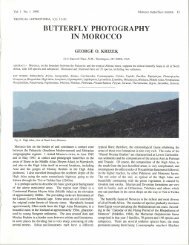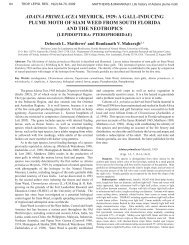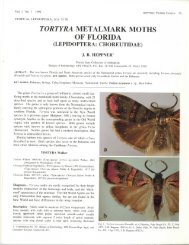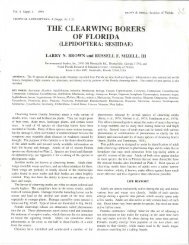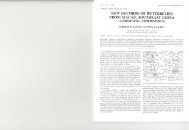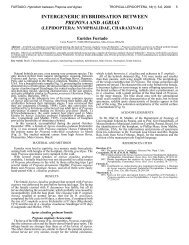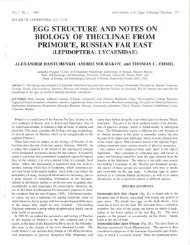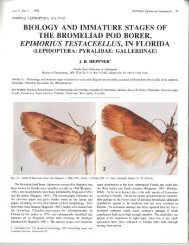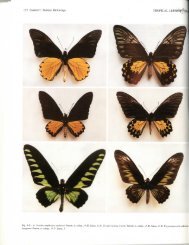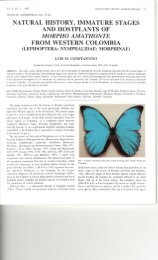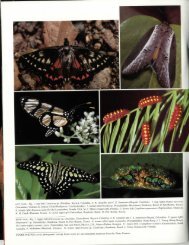eurema albula (pieridae) - Association for Tropical Lepidoptera
eurema albula (pieridae) - Association for Tropical Lepidoptera
eurema albula (pieridae) - Association for Tropical Lepidoptera
- No tags were found...
You also want an ePaper? Increase the reach of your titles
YUMPU automatically turns print PDFs into web optimized ePapers that Google loves.
Vol. 6 No. 1 1995 CHUAH and GUSHING: New Texas Records 43TROPICAL LEPIDOPTERA, 6(1): 43-44EUREMA ALBULA (PIERIDAE) ANDANTHANASSA ARGENTEA (NYMPHALIDAE):NEW RECORDS FOR THE UNITED STATES(LEPIDOPTERA: PAPILIONOIDEA)HOE H. CHUAH1 and DAVID S. CUSHING27746 Spruce Haven Dr., Houston, Texas 77095'; and1512 Jenny Lane, Richmond, Texas 77469, USA2ABSTRACT.- Two butterflies, Eurema <strong>albula</strong> (Cramer) and Anthanassa argentea (Godman & Salvin), new to the United States, were collected inthe lower Rio Grande Valley, Texas, in November 1993.KEY WORDS: Antigua, Argentina, Compositae, Costa Rica, distribution, El Salvador, Guatemala, hostplants, Leguminosae, Mexico, Nearctic,Nicaragua, Panama, Phyciodes, Phyciodini, St. Vincent, Texas, Tobago, Trinidad, West Indies.The lower Rio Grande Valley of Texas is well known as oneof the regions in southwestern United States where some tropical<strong>Lepidoptera</strong> reach their northernmost dispersal. Over the years,<strong>Lepidoptera</strong> from Mexico new to the United States are regularlydiscovered in this region. Some occurred as single recordedstrays, while some were able to 'establish temporary residencywith dynamic extirpation and reestablishment (Neck, 1976).Climatic conditions, presence of acceptable larval foodplants,nectar sources and habitats play important roles in the dispersalof these tropical species (Kendall and McGuire, 1984). Weobserved lush vegetation growth and abundant nectar sourcesduring our 12-14 November 1993 field trip, and found morespecies of strays and temporary migrants than we had everexperienced be<strong>for</strong>e. Two species of butterflies, new to the UnitedStates, were collected and are reported here.Eurema <strong>albula</strong> (Cramer, 1775)A female (Fig. 1) was collected by the junior author at about1000 hours, 13 Nov 1993, near the Rio Grande River in RomaLos-Saenz, Starr County, Texas (98° 59' 53"W, 26° 23' 39"N).The butterfly was flying slowly in a non-erratic straight line,about 0.5m above the ground.E. <strong>albula</strong> is widely distributed from Mexico, south to Argentinaand east to Antigua and St. Vincent in the West Indies (Riley,1975), Trinidad and Tobago (Barcant, 1970) where it wasreported to use Cassia (Leguminosae) as larval foodplant. Severalspecies of Cassia occur in the lower Rio Grande Valley, of whichC. alata L., C. corymbosa Lamarck, C. bicapsularis L. and C.laevigata Wildenow are cultivated as ornamental shrubs (Correlland Johnston, 1979). Along the river bank in the vicinity of RomaLos-Saenz, there are indeed Cassia shrubs. There<strong>for</strong>e, thespecimen collected could possibly come from a recently establishedpopulation or this female could Have laid eggs prior to itscapture, and established a breeding population under favorableconditions. At the time of capture, the identity of this species wasnot recognized. There<strong>for</strong>e, we did not search the area <strong>for</strong> anyother adults or Cassia foodplants <strong>for</strong> immatures.Anthanassa argentea (Godman & Salvin, 1882)A very worn male (Fig. 2) was collected by the senior authorat about 1230 hours, 14 Nov 1993 along a dirt road 1.6kmsoutheast of Penitas, Hidalgo County, Texas (98° 26' 28"W, 26°13' 39"N). It was nectaring on Eupatorium odoratum L. (Compositae),an excellent fall butterfly attractant. Other Phyciodini thatwere at the Eupatorium blossoms in the surrounding area were A.texana texana, Phyciodes vesta, P. phaon and P. tharos. However,the wing coloration and markings of A. argentea are sodistinctly different that it could not be confused with the aboveand was readily recognized as being new to the U.S. Furthersearch in the surrounding area did not turn up another adult. Inthe Allyn Museum collection, there are A. argentea specimensfrom Gomez Farias, Tamaulipas, Mexico, which is about 370kmsouth of the lower Rio Grande Valley, certainly a distance thatmigratory strays are capable of travelling. From the condition ofthe Penitas specimen, it was likely a migratory stray.A. argentea is found in Mexico, El Salvador, Guatemala andNicaragua where it is sympatric with A. atronia Bates. Itresembles A. atronia and was previously treated by Hall (1929)as one of its <strong>for</strong>ms. Higgins (1981) revised its status to a speciesrank based on constant differences in wing maculation betweenthe two. A. argentea can be differentiated from A. atronia by thedorsal chestnut-brown discal area, whereas A. atronia is moreuni<strong>for</strong>mly dark brown and the markings are usually obscured ifpresent. A. atronia is also more widely distributed, found inPanama and Costa Rica in addition to where A. argentea flies.The identification of this specimen was verified by J. D.Weintraub, who compared the dorsal and ventral photographswith the lectotypes of A. argentea and A. atronia in the Natural
44 CHUAH and GUSHING: New Texas Records TROPICAL LEPIDOPTERA2aFig. 1. Eurema <strong>albula</strong> ¥: a) dorsal view; b) ventral view.Fig. 2. Anthanassa argentea



